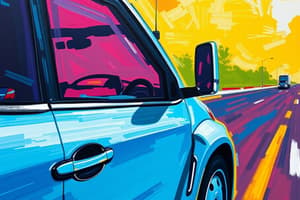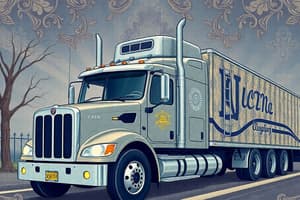Podcast
Questions and Answers
Who must obtain a CDL?
Who must obtain a CDL?
Any operator of a CMV with a GCWR of 26,001 lbs or more; vehicle required by federal regulation to be placarded while transporting hazardous material; vehicle designed to carry 16 or more persons, including the driver.
What are the classes of Commercial Drivers Licenses (CDL)?
What are the classes of Commercial Drivers Licenses (CDL)?
Class A - Combination vehicles with a GCWR of 26,001 or more pounds; Class B - Single Vehicles with a GCWR of 26,001 or more lbs.
What endorsements are available to CDL operators and what is their letter designation?
What endorsements are available to CDL operators and what is their letter designation?
Charter Bus (C), Combination Tank and Hazardous Material (X), Double/Triple Trailers (T), Passenger Vehicle (P), School Bus (S), Tank Vehicles (N), Vehicles carrying hazardous Material (H)
What is the minimum tire tread depth on a CMV?
What is the minimum tire tread depth on a CMV?
Will broken leaf springs put a truck out of service (OOS) on a roadside inspection?
Will broken leaf springs put a truck out of service (OOS) on a roadside inspection?
What are the 3 types of emergency equipment required on a CMV?
What are the 3 types of emergency equipment required on a CMV?
What are the two main causes of tire fires on a CMV?
What are the two main causes of tire fires on a CMV?
What are four main items to check for when pre-tripping the wheels on a CMV?
What are four main items to check for when pre-tripping the wheels on a CMV?
What is the safest way to begin a backing maneuver?
What is the safest way to begin a backing maneuver?
When is the safest time to downshift when going downhill?
When is the safest time to downshift when going downhill?
How can you communicate with other drivers while driving?
How can you communicate with other drivers while driving?
What is an effective way to find out if roads may be icing up?
What is an effective way to find out if roads may be icing up?
Is it always safe to travel at the maximum posted speed?
Is it always safe to travel at the maximum posted speed?
What is hydroplaning?
What is hydroplaning?
What is the most common type of turning accident in a CMV?
What is the most common type of turning accident in a CMV?
Flashcards are hidden until you start studying
Study Notes
CDL Requirements and Classes
- All operators of Commercial Motor Vehicles (CMV) must obtain a CDL if they operate a vehicle with a Gross Combination Weight Rating (GCWR) of 26,001 lbs or more.
- A CDL is also required for vehicles transporting hazardous materials that must be placarded, and for vehicles designed to carry 16 or more persons, including the driver.
- Class A CDLs cover combination vehicles with a GCWR of 26,001 lbs or greater, while Class B CDLs apply to single vehicles with the same GCWR requirements.
Endorsements for CDL Operators
- Various endorsements are available for CDL operators, each designated by a letter:
- C: Charter Bus
- X: Combination Tank and Hazardous Material
- T: Double/Triple Trailers
- P: Passenger Vehicle
- S: School Bus
- N: Tank Vehicles
- H: Hazardous Material
Vehicle Safety Regulations
- Minimum tire tread depth requirements for CMVs:
- 4/32nd of an inch for front or steer tires
- 2/32nd of an inch for all other tires
- Broken leaf springs result in a CMV being marked out of service if 1/4 of the springs are cracked or missing.
Emergency Equipment Requirements
- CMVs must carry three main types of emergency equipment:
- A properly charged and secured fire extinguisher
- Three red warning triangles
- Spare fuses, unless circuit breakers are installed
Tire Safety and Maintenance
- Two primary causes of tire fires on CMVs include under-inflated tires and dual tires making contact with each other.
- Key checks during a pre-trip inspection of wheels should include:
- Wheel and rim condition, ensuring proper alignment and integrity
- Tire condition, including inflation and absence of damage
- Lug nut status, looking for signs of rust or looseness
- Hub oil levels, ensuring no leaks are present
Safe Driving Practices
- The safest method to start a backing maneuver is to practice G.O.A.L: Get Out And Look to avoid unseen hazards.
- When descending a hill, selecting the correct gear prior to the descent is crucial for maintaining a safe speed without over-utilizing brakes.
Driver Communication Techniques
- Effective communication with other drivers involves using vehicle lights, signals, eye contact, and occasionally the horn.
Weather Awareness and Road Conditions
- To detect potential icing conditions, lower the driver’s window and check for ice buildup on the mirror or antenna.
- Maximum posted speed limits are based on optimal conditions suited for passenger vehicles, making them unsafe to follow strictly in adverse conditions.
Hydroplaning and Turning Accidents
- Hydroplaning occurs when water does not drain properly from under a tire, causing a loss of traction, and can occur with just 1/10th of an inch of water.
- The most frequent turning accident in CMVs is the "right side squeeze play," which can be avoided by using the trailer to block the right lane before turning left.
Studying That Suits You
Use AI to generate personalized quizzes and flashcards to suit your learning preferences.




